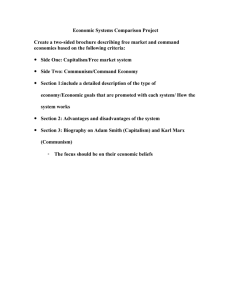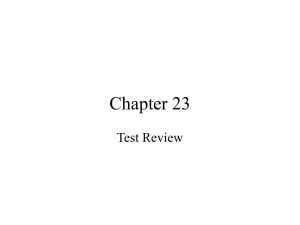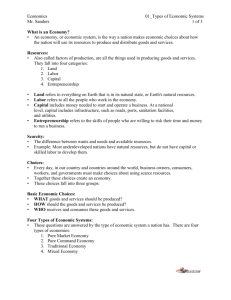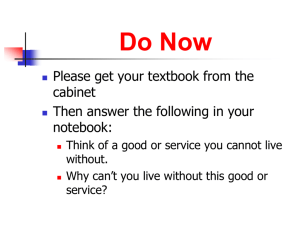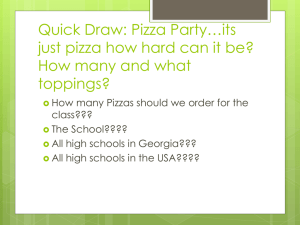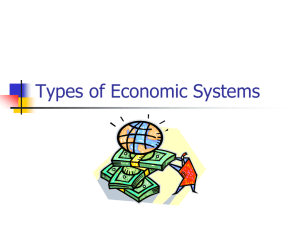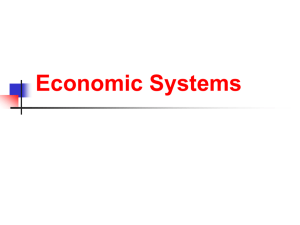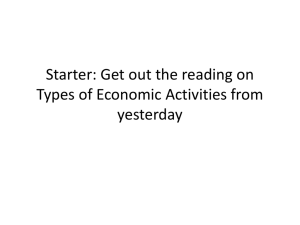Different world economies
advertisement
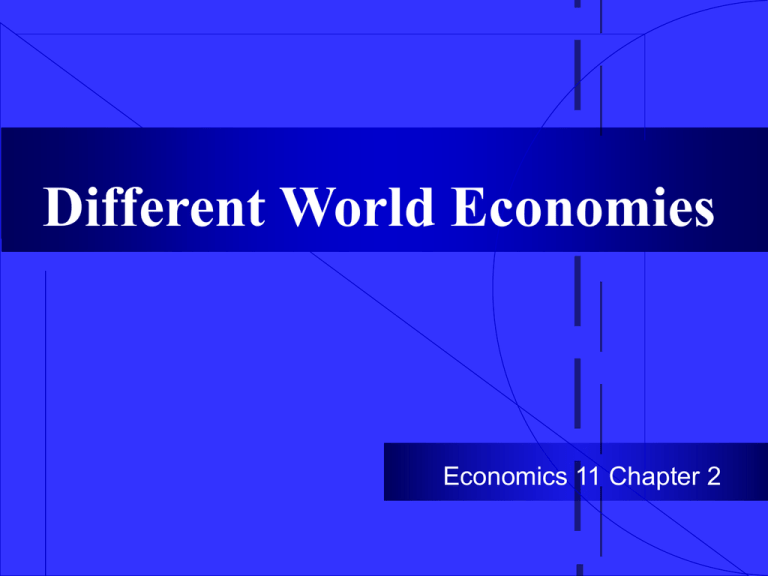
Different World Economies Economics 11 Chapter 2 Descriptive Overview: In this lesson, students will be exposed to four types of world economies. They will also learn the historical background that led to the formation of those economies, specifically command and mixed economies. Lesson Objectives/Goals Describe and compare the economic systems predominate in the world today. Compare and contrast traditional, command and market economies. Explain how mixed economies are a combination of other economic systems. Terminology/Vocabulary Capitalism (First World) Command Economy (Second World) Traditional Economy (Third World) Market Economy Mixed Economy Free Enterprise Adam Smith Adam Smith (1723-1790-Scotland) is considered the father of modern economic theory and capitalism. Best know for the concept of the “Invisible Hand” of capitalism that brings benefits to all of society through the self serving profit motive (innovations like those of Steve Jobs and Bill Gates) Karl Marx Karl Marx (1818-1883 Germany) Co-author with Freidrich Engels of The Communist Manifesto which popularized the theories that led to modern 20th Century communism in Russia, China, North Korea, Vietnam and Cuba. Traditional Economies Traditional economies are found in rural, non-developed countries Some parts of Asia, Africa, South America and the Middle East have traditional economies Customs govern the economic decisions that are made Modern Technology is not used in traditional economies. Traditional Economies Farming, hunting and gathering are done the same way as the generation before Economic activities are usually centered toward the family or ethnic unit (tribal clans) Men and Women are given different economic roles and tasks Command Economies The government or other central authority makes decisions and determines how resources will be used (quotas/five year plans) Change can occur relatively easily because the govt. forces it. There is little individual freedom or private property There is no competition Businesses are not run to create a profit but merely to provide services/goods Social Democratic (NDP) Socialism (Sweden) Communism (extreme case USSR, CHINA, CUBA) Command Economies Consumers have few choices in the market place Factories are concerned with quotas Shortages are common because of poorly run factories and farms (bread lineups in USSR were common) The government dictates the job in which you work “From each according to his ability, to each according to his need (or needs)” –Karl Marx Command Economies The government sets the prices of goods and services Examples of command economies: Cuba, North Korea and the People’s Republic of China Market Economies Resources are owned and controlled by individuals-private property is the norm Economic decisions are made by individuals competing to earn profits-The Profit motive decides the 3 questions Individual freedom is considered very important Economic decisions are made by the basic principals of supply and demand Profit is the motive for increasing work rather than quotas Market Economies Also called capitalist economies Laissez Faire economics- “to leave, to do” – government stays out of the economy and does not regulate it at all. The opposite is a government regulated economy (Canada, Sweden) or in the extreme a command economy like the former USSR. There are many economic freedoms There is competition among businesses Competition determines price which increase the quality of the product Mixed Economies Government and individuals share the decision making process (CANADA, France AND Britain …even the USA when Democrats are in power) Government guides and regulates production of goods and services offered Individuals own means of production Protects consumers and workers from unfair policies (gov’t regulated economies) such as those that caused the 2008 Great Meltdown in the USA. Most effective economy for providing goods and services but not individual wealth (Americans are usually far richer or far poorer than Canadians and Brits). Why is Canada a mixed Economy? | Why Review Four Types of Economics Traditional Economies Command Economies Market Economies Mixed Economies Ch. 2 National Decision Making The Individual and the Economy Three Major Questions 1. 2. 3. What are we going to produce? How is it produced? Who receives how much? Answers For The Three Major Questions 1. 2. 3. Pure Traditional Economy Pure Command Economy Pure Market Economy Economic Systems Model Question Traditiona Comma Market s l nd What? How? Whom? Adv. Disadv. Economic Systems Model Question Traditiona Comma Market s l nd What? How? Whom? Adv. Disadv. What we always have produced Economic Systems Model Question Traditiona Comma Market s l nd What? What we always have produced How? Same way we always have produced it. Whom? Adv. Disadv. Economic Systems Model Question Traditiona Comma Market s l nd What? What we always have produced How? Same way we always have produced it. Whom? Same amounts to the same people as in the past. Adv. Disadv. Economic Systems Model Question Traditiona Comma Market s l nd What? What we always have produced How? Same way we always have produced it. Whom? Same amounts to the same people as in the past. Adv. Stable. Environmentally friendly. Disadv. Economic Systems Model Question Traditiona Comma Market s l nd What? What we always have produced How? Same way we always have produced it. Whom? Same amounts to the same people as in the past. Adv. Stable. Environmentally friendly. Disadv. No new technology for material comfort and health. Economic Systems Model Questions Traditional What? What we always have produced How? Same way we always have produced it. Whom? Same amounts to the same people as in the past. Adv. Stable. Environmentally friendly. Disadv. No new technology for material comfort and health. Command Government decides. Focus on essentials, cultural activities and military. Market Economic Systems Model Questions Traditional Command What? What we always have produced Government decides. Focus on essentials, cultural activities and military. How? Same way we always have produced it. Government decides. Employ the most people. Whom? Same amounts to the same people as in the past. Adv. Stable. Environmentally friendly. Disadv. No new technology for material comfort and health. Market Economic Systems Model Questions Traditional Command What? What we always have produced Government decides. Focus on essentials, cultural activities and military. How? Same way we always have produced it. Government decides. Employ the most people. Whom? Same amounts to the same people as in the past. Government decides. Equality. Adv. Stable. Environmentally friendly. Disadv. No new technology for material comfort and health. Market Economic Systems Model Questions Traditional Command What? What we always have produced Government decides. Focus on essentials, cultural activities and military. How? Same way we always have produced it. Government decides. Employ the most people. Whom? Same amounts to the same people as in the past. Government decides. Equality. Adv. Stable. Environmentally friendly. Equality. Essential needs met Disadv. No new technology for material comfort and health. Market Economic Systems Model Questions Traditional Command What? What we always have produced Government decides. Focus on essentials, cultural activities and military. How? Same way we always have produced it. Government decides. Employ the most people. Whom? Same amounts to the same people as in the past. Government decides. Equality. Adv. Stable. Environmentally friendly. Equality. Essential needs met Disadv. No new technology for material comfort and health. Poor quality goods & services. Shortages. Market Economic Systems Model Questions Traditional Command Market Consumers vote with their purchases What? What we always have produced Government decides. Focus on essentials, cultural activities and military. How? Same way we always have produced it. Government decides. Employ the most people. Whom? Same amounts to the same people as in the past. Government decides. Equality. Adv. Stable. Environmentally friendly. Equality. Essential needs met Disadv. No new technology for material comfort and health. Poor quality goods & services. Shortages. Economic Systems Model Questions Traditional Command Market What? What we always have produced Government decides. Focus on essentials, cultural activities and military. Consumers vote with their purchases How? Same way we always have produced it. Government decides. Employ the most people. Producers have to keep costs low and quality high Whom? Same amounts to the same people as in the past. Government decides. Equality. Adv. Stable. Environmentally friendly. Equality. Essential needs met Disadv. No new technology for material comfort and health. Poor quality goods & services. Shortages. Economic Systems Model Questions Traditional Command Market What? What we always have produced Government decides. Focus on essentials, cultural activities and military. Consumers vote with their purchases How? Same way we always have produced it. Government decides. Employ the most people. Producers have to keep costs low and quality high Whom? Same amounts to the same people as in the past. Government decides. Equality. Producers and human resources that produce high demand, small supply products receive the most income. Adv. Stable. Environmentally friendly. Equality. Essential needs met Disadv. No new technology for material comfort and health. Poor quality goods & services. Shortages. Economic Systems Model Questions Traditional Command Market What? What we always have produced Government decides. Focus on essentials, cultural activities and military. Consumers vote with their purchases How? Same way we always have produced it. Government decides. Employ the most people. Producers have to keep costs low and quality high Whom? Same amounts to the same people as in the past. Government decides. Equality. Producers and human resources that produce high demand, small supply products receive the most income. Adv. Stable. Environmentally friendly. Equality. Essential needs met High quality, variety, and inexpensive goods. Disadv. No new technology for material comfort and health. Poor quality goods & services. Shortages. Economic Systems Model Questions Traditional Command Market What? What we always have produced Government decides. Focus on essentials, cultural activities and military. Consumers vote with their purchases How? Same way we always have produced it. Government decides. Employ the most people. Producers have to keep costs low and quality high Whom? Same amounts to the same people as in the past. Government decides. Equality. Producers and human resources that produce high demand, small supply products receive the most income. Adv. Stable. Environmentally friendly. Equality. Essential needs met High quality, variety, and inexpensive goods. Disadv. No new technology for material comfort and health. Poor quality goods & services. Shortages. Income inequity. Free Market Capitalism Private property rights Profit Consumer Sovereignty Self-Interest Competition http://www.scribd.com/doc/27961797/Capi talism-ppt The Economy of Canada Mixed market economy Capitalist/Free Market aspects(private property, free market, private companies, publicly traded companies) Socialist/Command Aspectsgovernment regulated banks, social programs (healthcare, welfare, free public schools), Central Bank that regulates the economy through setting interest rates Objectives (Economic Council of Canada - E.C.C.) 1. 2. 3. 4. 5. 6. 7. 8. Full Employment Stable Prices Balance of Trade Economic Growth Economic Justice Economic Freedom Economic Efficiency Reasonable Debt Capitalism vs. Socialism (extreme socialism-communism) Russia in the 1990s post Soviet communist era Definition of Capitalism According to Dictionary.com, Capitalism is… an economic system investment in and ownership of the means of production, distribution, and exchange of wealth is made and maintained chiefly by private individuals or corporations Definition of Socialism According to Merriam-Webster, Socialism is… Government ownership and administration of the means of production and distribution of goods A system of society or group living in which there is not private property A system or condition of society in which the means of production are owned controlled by the state and Capitalism vs. Socialism Capitalist countries: America Canada Brazil Japan Mexico Socialist countries: Cuba Saudia Arabia Iran North Korea Burma Mixed Economy According to dictionary.com, a Mixed economy is: An economy in which some industries are privately owned and others are publicly owned or nationalized Many capitalist economies are mixed economies (some capitalism and some socialism) Pros and Cons of Capitalism Pros Competition to provide goods and services keeps prices low Rewards hard work Provides choice Allows for the building up of wealth and possessions Consumers regulate the market Cons Exploits people who cannot compete Uneven distribution of wealth Creates a moneyoriented society Constant economic growth may deplete the earth’s resources A con: recessions and economic depressions 1929-39….2008-2011 (various) Great Recession - Wikipedia, the free encyclopedia Pros and Cons of Socialism Pros All members share benefits Those who cannot contribute may still participate (disabled, elderly) Each member’s survival needs are met Equal distribution of wealth No socioeconomic classes Cons No incentive to work harder No competition means no reward to be innovative New members to the community (immigrants) are seen as competition for limited goods and services Higher taxes Which is best: Capitalist economy, Socialist economy, or a Mixed economy? A free market exists with some regulation by the government People can create their own businesses and make a profit All businesses pay taxes, which benefit everyone Government subsidized programs Postal service Rail lines Libraries Health care Social programs Roads Infrastructure (bridges, freeways, etc.) Can you think of any others? What is Communism? Communism - a government where people shared work fairly and were paid equally. The word “Communism” comes from the Latin word “Communis” which means common or belonging to all. marxismbest2013.ppt The Beliefs of Communism The rich get richer. The poor get poorer. People wanted to make everything equal. The Goal of Communism Goal: to get rid of social classes and make everything fair for everyone. Do you agree? Or disagree? Based off of what you know, do you think Communism is a good idea? If yes: explain why If no: what are potential dangers of Communism? Capitalism An economic and political system in which a country's trade and industry are controlled by private owners for profit. Basics of Capitalism: Capitalism is said to promote economic growth and the overall standard of living. In other words, capitalism creates CAPITAL (money) …and lots of it. Basics of Capitalism: Buyers (people) influence the market through their demand and ability to purchase goods and services. There is very little government intervention. Producers (businesses) are motivated by profit (money) and therefore create whatever goods people will buy. In other words, the businesses run the economy, the government stays out of it! Do you agree? Or disagree? Based off of what you know, do you think Capitalism is a good idea? If yes: explain why If no: what are potential dangers of Capitalism? Problems with Capitalism: There is a growing gap between the rich and the poor. The rich get richer and the people who work for them remain poor. Problems with Communism: Lack of individuality Lack of choice Equal treatment for all, even if you work harder than all the rest People seen as “workers” not as spiritual beings with emotions, etc. Religion was banned and the family unit de-emphasized. Imperial Russia Pre-WWI Prior to WWI, Russia was a monarchy, ruled by the Romanov Dynasty. The Russian rulers were known as czars, the Russian equivalent of the word caesar. The Czar of Russia at the time was Nicholas II. Nicholas II, last czar of Russia Imperial Russia Pre-WWI The Russian people were not satisfied with Czarist rule, and prior to the war there were many who agitated for more self-government in Russia. As WWI began, Russia entered the war on the side of the Allies (Britain, France) against the Central Powers (Germany, Austria-Hungary, the Ottoman Empire). WWI did not go well for the Russians. They suffered many casualties, especially after the twin defeats of Tannenberg and the Masurian Lakes. The Germans, sensing that Russia was weak at this Vladimir Lenin point, helped send Vladimir Lenin to Russia, hoping he would cause trouble. Lenin had been a proponent of communism and an enemy of the czar before the war who had been exiled. Upon his return, he helped lead the Russian Revolution which established the Soviet Union. Russian Revolution of 1917 The Revolution was led by Lenin, and was successful in overthrowing the Czar and setting up a new government. The Russian Empire became the Union of Soviet Socialist Republics, or the USSR. It was to be a country led by communist ideals, a worker’s paradise. In this new state, there was no room for royalty; Nicholas II and the entire royal family (his wife, and their 5 children) were executed by firing squad. Early years of the Soviet Union Upon Lenin’s death in 1924, Joseph Stalin came to power. His goal was the creation of a model communist state. The goals of this state were agricultural and industrial growth. All private farms were abolished and replaced with collectives — large government-owned farms, each worked by hundreds of families. Joseph Stalin Soviet Union under Stalin’s rule Wanted to transform USSR from a backward rural nation into a great industrial power. Towards this end, created what were known as “Fiveyear plans” to direct industrialization. All economic activity was placed under state control. By 1937, the USSR had become the world’s 2nd largest industrial power, surpassed only by the USA. The cost of industrialization In his attempt to modernize the Soviet Union, Stalin was ruthless and did away with anyone who he thought opposed his power. The 1st people that fell victim to his policies were the kulaks, independent farmers. When collectivization began, these people were forced off their farms to work for the state. Those that did not comply were executed. The cost of industrialization Stalin also executed or imprisoned all his political enemies. One of the first people to fall under this category was Leon Trotsky, a fellow communist who Stalin had outmaneuvered to become Lenin’s successor. Trotsky fled Russia, first to Paris, and then eventually Mexico City. He was assassinated in 1940 by one of Stalin’s agents, stabbed to death with an ice pick. The Great Purge In the late 1930’s, Stalin secured his power and position by killing off many people in high level positions, including many who had been leaders of the Russian Revolution. The trials given to these people were a sham, their confessions of guilt tortured out of them. One result of this purge was that many of the Soviet Union’s best military minds were killed, a situation which left the state vulnerable in case of foreign invasion. The Holodomor During the years 1932-1933, the Ukraine, a territory of the Soviet Union, suffered from widespread famine and malnutrition. There was no reason for this famine however, because the Ukraine is the breadbasket of the Soviet Union. However, the government was collecting all the food for storage and not distributing it properly to the populace. As a result, millions (approx. 2-10) died from starvation. There were reports of widespread cannibalism in fact. Scholars still argue today whether the Holodomor was a planned genocide or not, though several countries officially recognize it as such. Countries which recognize the Holodomor as a genocide The Holodomor Totalitarian State In total, Stalin was responsible for the death of some 8 to 13 millions people. Millions more died in famine caused by trying to collectivize and industrialize the Soviet Union at such a breakneck pace. His establishment of the NKVD, a secret police, also led the people of the Soviet Union to live in fear for their lives. The state was firmly in control of every aspect of its citizens lives. Thus, the Soviet Union is known as a totalitarian state. After watching the sham trials of the late 30’s, many American communist began to desert the party. It was also quite evident that even though the Soviet Union espoused communist ideals, it was not living up to them. Stalin and his favorites had all the power while the life of the average peasant was hardly any better than it had been under the rule of the Czars. History’s Important? Russian Revolution in 1917 Established a communist state; became totalitarian Tried to create unified, central state where national and ethic differences were eliminated Historical Problems in Russia Non-Russian ethnic groups resisted assimilation Economic planning failed to meet the needs of the State (arms race with US) Communism never took root and lost influence Underlying Causes Years of Soviet military buildup at the expense of domestic development economic growth stalled/stagnant economy Failed attempts at reform war in Afghanistan general feeling of discontent, especially in the Baltic republics and Eastern Europe (i.e. Chernobyl) Mikhail Gorbachev March 11, 1985 Inherited many problems; recognized need for change (the economy needed fundamental reforms) Introduced twotiered policy of reform to meet the needs of the Russian state Policy #1: Glasnost Freedom of speech and free elections 1989 elections reformist politicians swept into power unwittingly unleashed emotions and political feelings that had been pent up for decades Policy #2: Perestroika Economic reform and rebuilding (complete economic restructuring) did not have the immediate results Gorbachev had hoped for and had publicly predicted Unsuccessful – bureaucratic corruption People used free speech to criticize Gorbachev Fall of the USSR Disintegration began on the peripheries Baltic nationalist movements; demanded autonomy challenge to glasnost Non-Russian minority groups agitated for independence during this period Gorbachev’s Response decision to not use military force to put down revolutions in Eastern Europe allowing revolutions to run their course would spell disaster for the Soviet Union Ultimately eroded the power of the Soviet Union during 1989 and 1990. August 1991 – August Coup “hard-line” Communists take over of government last-ditch effort to save USSR country went into an uproar; massive protests soldiers themselves rebelled – “can’t fire on our countrymen” Coup collapsed after 3 days Results of August Coup Gorbachev was unable to reestablish real control negotiated the transition of power made inevitable by the will of the people. December 1, 1991 all non-Russian republics declared independence (population wanted democracy) political movements which had emerged since the implementation of glasnost resulted in immediate fall Collapse of the Soviet Union a new entity was formed “Commonwealth of Independent Republics" Russia and 15 independent former USSR countries complete political independence, linked to other Commonwealth countries by economic, and military ties the Soviet Union, with its centralized political and economic system, had ceased to exist December, 1991 How does America fit in? Russia built up a military arsenal surpassing that of the United States enormous military expenses, in combination with collectivized agriculture and inefficient manufacturing were a heavy burden on the economy Reagan Administration persuaded Saudi Arabia to increase oil production resulted in a three times drop of oil prices in 1985; oil was the main source of Soviet export revenues recognized the change in the direction of Soviet leadership shifted to diplomacy to pursue substantial arms agreements four summit conferences between 1985 and 1988 believed that he could persuade the Soviets to allow for more democracy and free speech, this would lead to reform and the end of Communism President Ronald Reagan June 12, 1987, Berlin Wall Reagan challenged Gorbachev: “General Secretary Gorbachev, if you seek peace, if you seek prosperity for the Soviet Union and Eastern Europe, if you seek liberalization: Come here to this gate! Mr. Gorbachev, open this gate! Mr. Gorbachev, tear down this wall!” Response in the West victory for freedom triumph of democracy over totalitarianism, superiority of capitalism over socialism Rejoicing formidable enemy was brought to its knees Relief – end of Cold War which had hovered over the two superpowers Results of the Fall transformed the entire world political situation reformulation of political, economic and military alliances America sole military and world hegemonic power End of Cold War and MAD threat 2008’s Great Recession: the darkest days reminded citizens of the Great Depression ..\occupywallstreet.ppt The Men Who Crashed the World - Meltdown Part 1 – YouTube Meltdown -The men who crashed the world. Aljazeera PART 2 – YouTube Meltdown : The men who crashed the world PART 3 – YouTube The Men Who Crashed the World - Meldown Part 4 – YouTube Capitalism: A Love Story - Documentary - YouTube Chinese Economy from WWII - Present After WWII, the Communist Party gained a lot of support. Mao Zedong was the leader Mao’s China Mao Zedong used propaganda to spread the ideas of Communism and published “The Little Red Book” to teach people communist philosophies The Great Leap Forward - 1958 In 1958 Zedong began a radical program called the Great Leap Forward to increase production in farms and factories The Communists rushed to increase production and made people with little to no experience try to farm or produce steel in their backyards. The steel was of poor quality making it useless and the poor weather resulted in a widespread famine. An estimated 30 million people died of starvation (“sparrow story”). The Cultural Revolution - 1966 Create a society with no ties to the past: Closed schools Urged students to rebel against their teachers and parents, these people were called “Red Guards” Many Ancient Chinese buildings were destroyed Anyone opposing Zedong was attacked by the young Red Guards Finally, they began to turn against Zedong and were eventually imprisoned Hundreds of thousands of people were killed China was in turmoil! The Four Modernizations - 1981 Deng Xiaoping became the new leader of China in 1981. Over the past 20 years, China has seen slow changes in their economy, allowing some free enterprise (meaning that the government does control ALL aspects of the economy) Xiaoping led The Four Modernizations: Farming Industry Science Defense Modern China Today, China is a major economic power China still only has one political party, the Chinese Communist Party, meaning there is no political freedom In 1989, people gathered in Tiananmen Square in China’s capital to protest for democracy. The government sent in troops and tanks, 1000’s were killed or wounded. Modern China There is still a need for human rights reforms… China today is one of the world’s greatest manufacturing countries While the economy is slowly changing, there is not much room for political change given the fact that there is only one political party allowed. Free speech is limited. Hong Kong Protests 2014 Hong Kong Protests Spread as 'Umbrella Revolution' Takes Hold - NBC News Inferring what you know… Based off of what you know about Mao Zedong, what is the irony of this political cartoon, and what it is trying to communicate? Economy of the Former Soviet Union’s economy led it to embrace Glasnost and Perestroika in late 1980s and shift towards a market economy in the 1990s. Failure of coordination (quotas of useless goods-all LARGE NAILS) Inadequate quality control (poor consumer goods like Ladas) Lack of incentives (no profit motive to encourage hard work or innovation) Pollution due to lack of environmental regulations and a focus on shifting from agrarian to industrial society Richest Capitalists Project capitalistswealthiestproject.doc CAPITALISM/FREE MARKET VS COMMAND/COMMUINISM/MARXISM/SOCIALISM Watch Capitalism: A Love Story Online | Netflix H:\economics 11\marxismbest2011.ppt Capitalism and Socialism: Crash Course World History #33 – YouTube Bill Maher Demystifies Socialism & Compares the American Model with the European Model – YouTube Marxist Philosophy - YouTube Communism: The Promise and The Reality - Red Flag [pt 1/6] – YouTube Communism: The Promise and The Reality - Red Flag [pt 2/6] – YouTube Gulag: Many Days, Many Lives | Days and Lives – YouTube Frozen to death - Siberian gulags – YouTube The Collapse of the Soviet Union – YouTube Berlin Wall Erected - A Day that Shook the World [HD] - YouTube Nov. 10, 1989: Celebration at the Berlin Wall - YouTube Obama Socialist: President Obama in His Own Words is Obama Socialist – YouTube Socialism in America – YouTube What is Socialism? - YouTube The Lost World of Communism (Part 1) - YouTube
